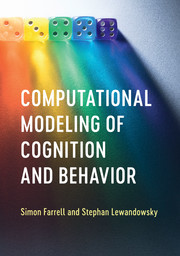Book contents
- Frontmatter
- Dedication
- Contents
- List of Illustrations
- List of Tables
- List of Contributors
- Preface
- Part I Introduction to Modeling
- Part II Parameter Estimation
- Part III Model Comparison
- Part IV Models in Psychology
- 12 Using Models in Psychology
- 13 Neural Network Models
- 14 Models of Choice Response Time
- 15 Models in Neuroscience
- Appendix A Greek Symbols
- Appendix B Mathematical Terminology
- References
- Index
13 - Neural Network Models
from Part IV - Models in Psychology
Published online by Cambridge University Press: 05 February 2018
- Frontmatter
- Dedication
- Contents
- List of Illustrations
- List of Tables
- List of Contributors
- Preface
- Part I Introduction to Modeling
- Part II Parameter Estimation
- Part III Model Comparison
- Part IV Models in Psychology
- 12 Using Models in Psychology
- 13 Neural Network Models
- 14 Models of Choice Response Time
- 15 Models in Neuroscience
- Appendix A Greek Symbols
- Appendix B Mathematical Terminology
- References
- Index
Summary
The ability to learn is a fundamental one. Many models of cognition incorporate some form of learning, as it is rarely the case that performance on a task is unaffected by experience. This chapter presents a family of models that provide a simple and profound architecture for understanding memory and how we learn about regularities in our world.
Neural network models, or connectionist models, model human behavior using structures and representations that loosely capture our understanding of how the brain functions. Although some models do attempt to capture fine-grained details of the operation of neurons, the framework we discuss here abstracts some general operating principles from the brain and uses these to account for performance on learning and memory tasks. Most connectionist models have the following features in common:
The modeling architecture is composed of units (“neurons”) connected by weights;
Each unit has its own firing rate;
The pattern of activation (i.e., firing rates) across an ensemble of units can be treated as a representation;
The activity of a unit is determined by the incoming weights, and the activity of the units that are passing activation through those weights;
Learning is accomplished by modifying the connection strengths – the weights – between units.
Don't worry if you found that description very abstract – it is! Like many things, neural networks are better understood by example than by description. We next go through a simple and popular example of a connectionist model to put some flesh on this abstract description.
Hebbian Models
The Hebbian Associator
Associative memory refers to our ability to remember pairings between items or objects. One example of an associative memory task is the cued recall task, where a person is shown pairings of stimuli and responses, and must produce the appropriate response on seeing a stimulus. A real-world example of a cued recall task is remembering someone's name when you see their face at a conference. Here, we will assume that the stimuli and responses are both words; so, for example, if the word trench has been paired with the word scissors, then the goal is to say scissors when the word trench is later seen again.
Information
- Type
- Chapter
- Information
- Computational Modeling of Cognition and Behavior , pp. 334 - 368Publisher: Cambridge University PressPrint publication year: 2018
